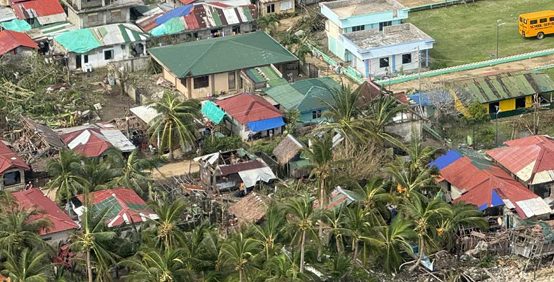SILAGO, SOUTHERN LEYTE — The Municipality of Silago is reeling from catastrophic destruction after Typhoon Tino made landfall at midnight on November 4, 2025, tearing through homes, roads, and lifelines in what local officials describe as devastation comparable to or worse than super typhoons Yolanda and Odette.
In an emergency meeting at 1:00 p.m. the same day, the Municipal Disaster Risk Reduction and Management Council (MDRRMC) formally recommended to the Sangguniang Bayan the declaration of a State of Calamity over the entire town, citing “extensive and widespread devastation” and the immediate need for external aid.
According to Mayor Lemuel Honor, Silago is now “in survival mode.” Food and clean drinking water are no longer available across most barangays, power and communications are down, and road access from Abuyog–Silago and Hinunangan–Silago remains impassable due to landslides, fallen trees, and heavy debris. Only a single Starlink satellite connection at the MDRRMO Operations Center in Barangay Poblacion 3 (Tubod) remains functional, serving as the town’s lone communication lifeline.
Despite the ferocity of the storm, no casualties have been reported, thanks to early force evacuations conducted before landfall. Still, the human toll is staggering: initial reports indicate around 1,713 families (5,449 individuals) have sought refuge in evacuation centers within Silago. Across the Eastern Visayas region, about 17,124 families (59,918 persons) have been affected by Typhoon Tino’s onslaught, according to national disaster monitoring agencies.
Damage and Destruction
The MDRRMO’s rapid assessment paints a grim picture of the damage. Hundreds of houses were flattened, while many others lost roofs and walls. Key public infrastructure—including barangay halls, schools, and rural health centers—was damaged or rendered inoperable. Flooding and strong winds uprooted trees, toppled electric poles, and washed out portions of local roads, cutting off the municipality from neighboring towns.
Preliminary estimates place Silago’s housing damage costs between ₱49 million and ₱246 million, depending on the severity of structural repairs required. If total reconstruction is needed for the worst-hit homes, losses could soar to ₱492 million. These figures, which cover residential destruction alone, exclude additional losses in agriculture, fisheries, and public infrastructure, which are still being validated by the Provincial Disaster Risk Reduction and Management Office (PDRRMO) and the Department of Public Works and Highways (DPWH).
Officials warn that restoring access roads, clearing debris, and rehabilitating basic utilities could require ₱20 million to ₱100 million more in emergency logistics and engineering support.
Relief and Appeals
Silago Mayor Honor, and MDRRMO head have issued an urgent appeal for assistance from national agencies, private donors, and humanitarian organizations. Immediate priorities include food packs, clean drinking water, basic medicines, first-aid supplies, temporary shelter materials, and heavy equipment for road clearing and debris removal.
“All barangays are affected. We have no clean water and limited food supply. We need your compassion and help to rebuild our town,” the MDRRMO said in its official statement.
Provincial authorities have dispatched rapid assessment teams and initial relief goods, while coordination with the Department of Social Welfare and Development (DSWD) and Office of Civil Defense (OCD) is underway for sustained relief and rehabilitation operations.
Moving Forward
The declaration of a State of Calamity will allow the municipal government to tap its calamity funds, enforce price controls on essential goods, and fast-track procurement and rehabilitation processes. MDRRMC officials emphasize that swift approval is critical to prevent a secondary crisis of hunger and disease as stranded communities await aid.
Typhoon Tino, packing maximum sustained winds of 150 km/h and gusts reaching 205 km/h, crossed Southern Leyte and moved westward toward the Visayas, leaving a trail of wreckage before expectedly exiting the Philippine Area of Responsibility by Thursday.
As Silago struggles to recover, its residents are calling for solidarity and swift action. “Our town is devastated—but not defeated,” one MDRRMC officer said. “We survived Tino, but we cannot survive the aftermath alone.”
Photo: Municipality of Silago



 Hope Amid Ruins: Communities of Homonhon Rise After Typhoon Tino’s Wrath
Hope Amid Ruins: Communities of Homonhon Rise After Typhoon Tino’s Wrath  Romualdez, Tingog Partylist Continue Relief Efforts for Areas Hit by Successive Typhoons ‘Tino,’ ‘Uwan’
Romualdez, Tingog Partylist Continue Relief Efforts for Areas Hit by Successive Typhoons ‘Tino,’ ‘Uwan’  Two Storms in Samar: Soldiers Face Rebels and Typhoon Tino in a Night of Courage and Chaos
Two Storms in Samar: Soldiers Face Rebels and Typhoon Tino in a Night of Courage and Chaos  Tacloban Police Arrest First-Time Offender, Seize P34K Worth of Suspected Shabu
Tacloban Police Arrest First-Time Offender, Seize P34K Worth of Suspected Shabu  DSWD Distributes Over P6.4M Aid After Super Typhoon ‘Uwan’
DSWD Distributes Over P6.4M Aid After Super Typhoon ‘Uwan’  Dulag’s Resilience: Communities Standing Strong Through Typhoon Tino
Dulag’s Resilience: Communities Standing Strong Through Typhoon Tino